Fuji - Hakone

Mount Fuji
Mount Fuji (Fujisan) is with 3776 meters Japan's highest mountain. It is not surprising that the nearly perfectly shaped volcano has been worshipped as a sacred mountain and experienced big popularity among artists and common people.
Mount Fuji is a dormant volcano, which most recently erupted in 1708. It stands on the border between Yamanashi and Shizuoka Prefectures and can be seen from Tokyo and Yokohama on clear days.
The easiest way to view Mount Fuji is from the train on a trip along the Tokaido Line between Tokyo and Osaka. If you take the shinkansen from Tokyo in direction of Nagoya, Kyoto and Osaka, the best view of Mount Fuji can be enjoyed from around Shin-Fuji Station on the right hand side of the train, about 40 to 45 minutes after leaving Tokyo.
Note however, that clouds and poor visibility often block the view of Mount Fuji, and you have to consider yourself lucky if you get a clear view of the mountain. Visibility tends to be better during the colder seasons of the year than in summer, and in the early morning and late evening hours.
If you want to enjoy Mount Fuji at a more leisurely pace and from a nice natural surrounding, you should head to the Fuji Five Lake (Fujigoko) region at the northern foot of the mountain, or to Hakone, a nearby hot spring resort.
Mount Fuji is officially open for climbing during July and August via several routes.
Hakone
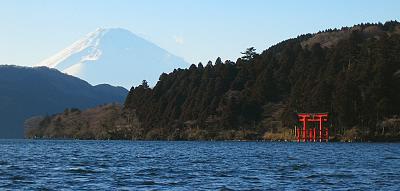
Hakone is part of the Fuji-Hakone-Izu National Park, less than 100 kilometers from Tokyo. Famous for hot springs, outdoor activities, natural beauty and the view of nearby Mt. Fuji, Hakone is one of the most popular destinations among Japanese and international tourists looking for a break from Tokyo.
Hot Springs
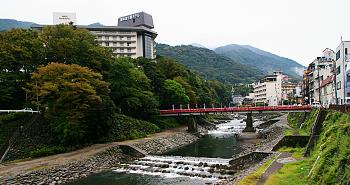
Hakone has been one of Japan's most popular hot spring resorts for centuries. Nowadays, more than a dozen springs provide hot spring water to the many bath houses and ryokan in the Hakone region.
Yumoto, at the entrance to the Hakone area near Odawara, is Hakone's most famous hot spring with a particularly long history, high quality water and numerous baths and inns. But many more hot spring baths can be found in the valleys and mountains of Hakone and at the shores of Lake Ashi.
Visitors can enjoy a hot spring bath in a public bath house or ryokan, as many ryokan open their baths not only to staying guests but also to daytime visitors. While staying guests can use the baths for free, daytime visitors pay an admission fee of typically between 500 and 2000 Yen.
Below is a small selection of baths, which are open to the general public (shown as blue marks on the map):

 | Yumoto: Tenzan Open daily 9:00 to 22:00; 1200 Yen; Short walk from "Oku-Yumoto Iriguchi" bus stop (5 minutes, 220 Yen from Yumoto Station along the Old Tokaido) |
 | Yumoto: Yu No Sato Okada Open daily 11:00 to 23:00; 1600 Yen on weekdays, 1800 Yen on weekends/holidays; 10 minute hotel shuttle bus ride from Yumoto Station (100 Yen) to Okada Hotel |
 | Yumoto: Hakone No Yu Open daily 10:00 to 22:00; 1000 Yen; A few steps from "Dai No Chaya" bus stop (5 minutes, 220 Yen from Yumoto Station along the Old Tokaido) |
 | Yumoto: Kappa Tengoku Open daily 10:00 to 22:00; 750 Yen; Less than 5 minutes on foot, just behind Hakone-Yumoto Station. |
 | Miyanoshita: Rakuyujurin Shizenkan Open daily 10:00 to 20:00, closed on Wednesdays; 2500 Yen; 5 minute walk from "Hotel-mae" bus stop and the Fujiya Hotel or a 10 minute walk from Miyanoshita Station. |
 | Kowakidani: Yunessun Open daily 9:00 to 19:00 (to 18:00 in winter), Mori No Yu until 20:00; 3000 Yen (Yunessun), 1600 Yen (Mori No Yu), 3500 Yen (combined), higher prices on weekends/season; A few steps from Yunessun or Kowakien bus stop (20 minutes, 560 Yen from Yumoto Station). |
Lake Ashi
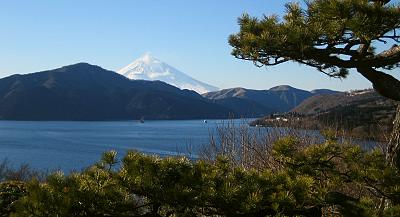
Lake Ashi (Japanese: Ashinoko) was formed in the caldera of Mount Hakone after the volcano's last eruption 3000 years ago. Today, the lake with Mount Fuji in the background is the symbol of Hakone.
The best views of the lake in combination with Mount Fuji can be enjoyed from Moto-Hakone, from the Hakone Detached Palace Garden and from the sightseeing boats cruising the lake.
Note however, that clouds and poor visibility often block the view of Mount Fuji, and you have to consider yourself lucky if you get a clear view of the mountain. Visibility tends to be better during the colder seasons of the year than in summer, and in the early morning and late evening hours.
Two companies, Hakone Sightseeing Boats and Izuhakone Sightseeing Boats, operate boats between Moto-Hakone and Hakonemachi at the lake's southern shores and Togendai and Kojiri at the northern shores.
A boat cruise from one end of the lake to the other takes roughly 30 minutes and costs 970 Yen. The Hakone Free Pass is valid on the pirate ship shaped Hakone Sightseeing Boats but not on boats operated by Izuhakone.
From Odawara and Hakone-Yumoto
Frequent buses connect Odawara via Hakone-Yumoto with Moto-Hakone and Hakonemachi at the southern end of Lake Ashi. The one way journey from Odawara takes about 50 minutes and costs 1150 Yen. From Hakone-Yumoto it takes about 35 minutes and costs 930 Yen. The Hakone Free Pass is valid on Hakone Tozan buses but not on Izuhakone buses.
There is also a frequently served Hakone Tozan Bus line from Odawara via Hakone-Yumoto to Togendai at the northern end of Lake Ashi (covered by the Hakone Free Pass). The one way journey from Odawara takes about 50 minutes and costs 1200 Yen. From Hakone-Yumoto it takes about 35 minutes and costs 1020 Yen.
A slow and scenic way of approaching Lake Ashi from Odawara or Hakone-Yumoto is taking the Hakone Tozan Railway to Gora, followed by a cablecar and ropeway ride to Togendai at the northern end of of the lake. From Togendai one can continue by sightseeing boat to Moto-Hakone or Hakonemachi. The whole journey is covered by the Hakone Free Pass.
From Yugawara
There are buses from Yugawara Station to Hakonemachi and Moto-Hakone (operated by Hakone Tozan and Izuhakone). Each company operates about one bus per hour in direction of Hakone during mornings only and in direction of Yugawara during afternoons only.
The one way journey from Yugawara to Moto-Hakone takes 45-60 minutes and costs 1250. The Hakone Free Pass is valid on Hakone Tozan buses but not on Izuhakone buses.
From Atami
There are buses (operated by Izuhakone Bus) from Atami Station to Hakonemachi every hour. The one way journey takes about 60 minutes and costs 1150 Yen. The Hakone Free Pass is not valid on Izuhakone buses.
From Mishima
There are buses from Mishima Station to Hakonemachi and Moto-Hakone (operated by Numazu Tozan Tokai Bus) every hour. The one way journey from Mishima to Moto-Hakone takes about 50 minutes and costs 1000 Yen. The Hakone Free Pass is valid on these buses.
From Gotemba
There are two buses per hour between Gotemba Station and the northern and eastern shores of Lake Ashi (operated by Odakyu Hakone Highway Bus). The one way journey from Gotemba to Togendai takes about 30 minutes and costs 990 Yen. The Hakone Free Pass is valid on these buses.
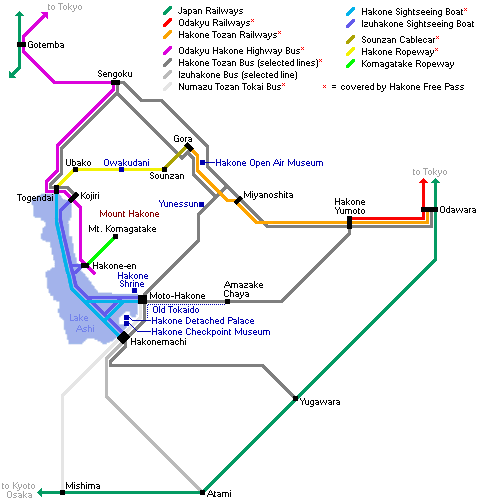
Hakone Detached Palace

Hakone Detached Palace used to serve as a summer palace for the Imperial Family, but was later opened to the public. It is located at the southern shores of Lake Ashi on the peninsula between Moto-Hakone and Hakonemachi.
The relatively small and simple palace building is surrounded by a beautiful park, which offers nice walking trails and scenic views of Lake Ashi and Mount Fuji, if visibility permits. Visibility tends to be better during the colder seasons of the year than in summer, and in the early morning and late evening hours.
 |  |
Hakone Detached Palace is located on the peninsula between Moto-Hakone and Hakonemachi. It can be reached from either town in a 10-15 minute walk.
Hakone Tozan Railway

A ride on the Hakone Tozan Railway is a treat not only for railway fans: The small train winds itself through a narrow, densely wooded valley over many bridges and trough numerous tunnels, stopping at small stations along the way and changing directions at three switchbacks.
The Hakone Tozan Line consists of two sections, a less spectacular section from Odawara to Hakone-Yumoto which is also used by Odakyu trains from central Tokyo, and the spectacular section from Hakone-Yumoto to Gora, where many travelers transfer to the cablecar towards Lake Ashi.
The 35 minute train ride from Hakone-Yumoto to Gora is especially spectacular in June and July when thousands of ajisai (hydrangea) are in bloom along the tracks and are illuminated in the evenings.
Trains run every 10-20 minutes between Hakone-Yumoto and Gora. The one way fare from Hakone-Yumoto to Gora is 650 Yen. The Hakone Free Pass is valid on the Hakone Tozan Railway.
Owakudani
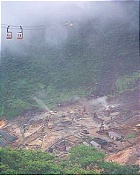 |  |  |
Owakudani is the area around a crater created in the last eruption of Mount Hakone 3000 years ago. Sulfurous fumes, hot springs and hot rivers can be experienced on a walk around the area. Eggs, boiled in the naturally hot waters, are said to prolong one's life by seven years and are readily available for sale.
Owakudani is a station along the Hakodate Ropeway from Sounzan to Togendai. Sounzan is accessible from Hakone-Yumoto by Hakone Tozan Railway and cablecar with a transfer in Gora. Togendai is located at the shores of Lake Ashi and is connected by boat with Moto-Hakone and Hakonemachi.
Hakone Shrine
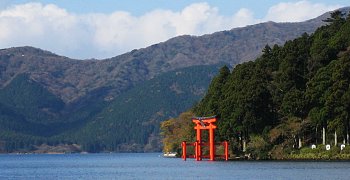
Hakone Shrine stands at the foot of Mount Hakone along the shores of Lake Ashi. The shrine buildings are hidden in the dense forest, but are well advertised by torii gates standing prominently in the lake and the main street of Moto-Hakone.
The Hakone Shrine Motomiya ("original Hakone Shrine") is located at the summit of Mount Komagatake, one of Mount Hakone's multiple peaks, and is accessible by the Komagatake Ropeway from Hakone-en (not covered by the Hakone Free Pass).
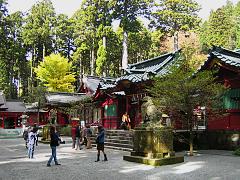 | 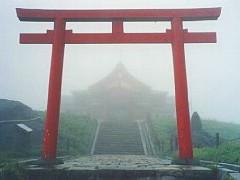 |
Hakone Shrine is a 5 minute walk from the Moto-Hakone boat pier, which again is a 40 minute bus ride from Hakone-Yumoto.
Hakone Shrine Motomiya is a short walk from the top station of Komagatake Ropeway, which departs from Hakone-en at the shores of Lake Ashi. A round trip ticket costs 1050 Yen. The Hakone Free Pass cannot be used on this ropeway.
Old Tokaido
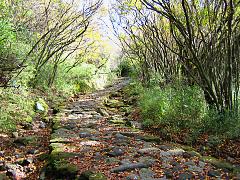 |  |
Hakone used to be an important checkpoint along the Tokaido, the highway which linked Edo (Tokyo) with Kyoto during the Edo Period.
A short, cedar lined passage of the old Tokaido and a museum about the former Hakone Checkpoint (under renovation until spring 2007) can be found between Moto-Hakone and Hakonemachi at the shores of Lake Ashi. The checkpoint used to control the traffic along the highway.
A longer passage of the old Tokaido with some original stone pavement can be walked between Moto-Hakone and Hakone-Yumoto. The best preserved section leads from Moto-Hakone to the Amazake Chaya (about 30-60 minutes), a tea house serving amazake (hot, sweet rice wine) and various Japanese style snacks.
Not much of the old pavement remains on the section between the Amazake Chaya and Hatajuku (about 30-60 minutes), but the walking trail is still attractive. Between Hatajuku and Hakone-Yumoto (60-120 minutes), however, walkers need to follow the street which is not particularly pleasant.
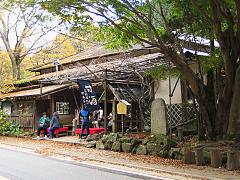 | 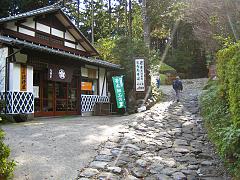 |
Two Hakone Tozan buses per hour run along the Old Tokaido between Hakone-Yumoto and Moto-Hakone, stopping at Hatajuku (15 minutes, 380 Yen from Yumoto) and the Amazake Chaya (25 minutes, 680 Yen) along the way. In the early morning and in the evening, buses operate between Hakone-Yumoto and Hatajuku only. The Hakone Free Pass is valid on these buses.

Hakone Open Air Museum
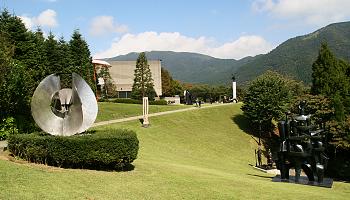
The Hakone Open Air Museum (Japanese: Hakone Chokoku No Mori Bijutsukan), successfully attempts to create a harmonic balance of nature and art by exhibiting various sculptures on its spacious grounds in combination with beautiful views of the surrounding valley and mountains.
Besides the sculptures, the Hakone Open Air Museum features various indoor galleries, including a sizable Picasso Collection, consisting of paintings, prints, sculptures and ceramic creations.
The Hakone Open Air Museum can be reached in a short walk from Chokoku No Mori Station on the Hakone Tozan Railway (30 minutes, 390 Yen from Hakone-Yumoto, covered by the Hakone Free Pass), the last station before the terminal station of Gora.